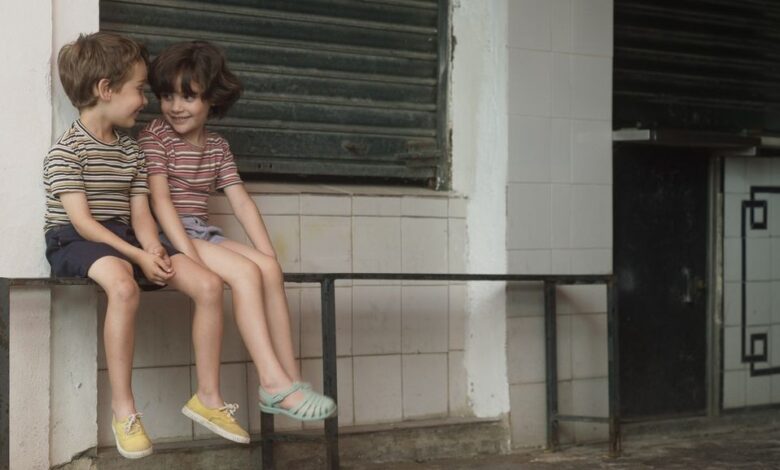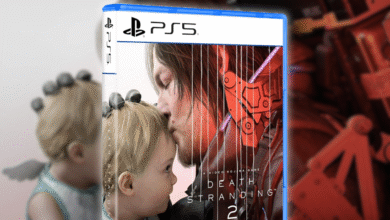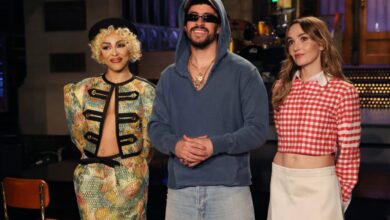Paz Vega on Directorial Debut ‘Rita’ as a “Love Letter to My Childhood” With Its Young Stars as Its “Soul”

You may have enjoyed Spanish actress Paz Vega‘s performances on the big screen in Spanglish, Sex and Lucia, Acts of Vengeance, or Rambo: Last Blood, among others. Or you may have seen her in such TV series as The OA or Netflix heist drama Kaleidoscope.
Now, she has written and stepped behind the camera for her directorial debut Rita, which celebrated its world premiere on Friday evening during the 77th edition of the Locarno Film Festival on the Swiss town’s picturesque Piazza Grande. Plus, she plays the mother in the movie. The cast also includes Sofía Allepuz, Alejandro Escamilla, and Roberto Álamo.
“Seville, summer of 1984. Rita and Lolo are brother and sister, seven and five years old, and live at the heart of a humble working-class family,” reads the film’s plot description. “Rita dreams of going to the beach, but at home, her father’s word is law, always. For the first time, Rita starts to question why things are like this. She also starts to realize that her home is becoming less and less safe, especially for her mother.”
You can watch a clip from the film on the Locarno festival website here.
Before the world premiere of Rita, Vega shared with THR‘s Georg Szalai in a Zoom interview what led her to make the film, her experience with writing and directing, why it’s all about the children’s perspective, and what’s next for her.
How did you come up with the idea and concept for Rita?
I always wanted to see a movie about this subject. I love the idea of talking about something dark but in a light way. And I wanted to create a love letter to my childhood, a love letter to a time that is past and is not going to happen anymore. I wanted to talk about a specific moment in Spain in the ’80s. We came from dictadura [the dictatorship of Francisco Francom which lasted 1939-1975]. And the ’80s were the explosion of everything, everything new and freedom. But people weren’t prepared for that freedom.
This is reflected in the movie when they talk about a new law that allows divorce and stuff like that. And you think, “Oh, everybody’s going to divorce because now you are free.” But no, people weren’t prepared for that. The people were scared of getting freedom. So there were so many things that I wanted to explore in my first movie.
You called Rita a love letter to your childhood. How much of the things we see in your film really happened to you or people you know?
It is a very personal story. When I started to write the script, for me it was easier to write about something that I knew. I could place this story in this past time. We have the same problems and issues now but I don’t know what it is like to be a child right now. So I said, “Let’s go to the past.” And when I went to the past, I went to my own childhood.
I discovered so many things. I felt that it’s more interesting to talk about the past because we don’t really know the past. I mean, we have and know our own memories. We know our own childhood. And I thought that it could be nice to make a movie that connects with your own childhood. So, I decided, “Let’s go to the ’80s. Let’s go to my own moment when I was seven years old in Sevilla.” The film is [set] almost in my own neighborhood. I think that makes the movie very, very believable and real. And for me, there was real pressure, and it was very, very emotional.

‘Rita’
Courtesy of Locarno Film Festival
The two kids who play Rita and her brother are so good and natural. How did you find and cast them?
The kids are my angels in the movie. They are the soul of the movie. It was very important to find the right kids because they are in every take. We saw so many kids, around 200. Sofía was the first one I saw because our casting director told me, “I have a girl.” She did a short movie before, and it was very good. But I didn’t like that she had long hair and was very little. So, I saw 200 girls and then said, “Hmm, why don’t we go back to the first one? Let’s see her in person.” And as soon as she entered, I fell in love with her. There was a connection, and I got goosebumps. It was amazing. After cutting her hair, it was the image I had of Rita, and everything was magic.
And for the two boys who play Rita’s brother and the neighbor kid, this was the very first thing they have ever done. They didn’t do anything before. The neighbor plays [soccer], and the other one has been doing theater in school. But they had never been in front of the camera. They had to learn all the process. We worked with them for around two months before the film. It was very, very detailed. But there was this connection between them even though they didn’t know each other before.
How early did you know that you wanted to focus on the kids instead of your mother character or other grown-ups?
From the beginning. The core of the story is seen through the eyes of the kids. I made many decisions in terms of framing because I wanted the audience to just go with the kids. I didn’t want to show anything else. Everything else is outside the frame. I wanted to focus on their reaction because we need to see how difficult it can be for kids sometimes to deal with the adult universe.
How did you decide on the balance between idyllic scenes of childhood and the danger that may be lurking in the world of adults?
I feel that the narrative of my movie is sometimes not logical. It’s more about feelings. I want you to feel happy with them, and I want you to feel scared with them. Because kids are like that. They are very present in the moment. When Rita and Lolo have the chance to go to the swimming pool, they are so happy. And suddenly, in one moment, everything changes. Sometimes the adults don’t have that sensibility and are just focused on their own problems. And those problems can affect kids in a very bad way.
That is what happens in the movie. Kids can be very happy and accept death. I remember when I was a child, I lost my grandma, and I never cried because, to me, it was normal and okay. She died, and she is in heaven. She is a star. It’s not like that for us adults. For us, it’s a drama. For the kids, death is part of life. And that’s beautiful. So I like all this contrast in the movie. It’s a drama, of course. But there are also light moments. There is a lot of light and hope in it.

‘Rita’
Courtesy of Locarno Film Festival
I enjoyed the kids’ enthusiasm about going to the pool etc. I recently got similarly excited when I ordered coffee and a particularly tasty-looking cake in a coffee shop…
It’s good to keep that energy and that feeling. The problem is: when we grow up, we lose all those feelings and that joy, and that’s bad.
You portray some toxic masculinity in the 1980s. Do you feel there has been much improvement or change since then?
That’s a big question. When I talk with people who have watched the movie, everybody recognizes someone around them like [characters in the film], especially in the past – our parents, our grandparents are a bit like this because that was society. But in the film, these people are not antagonists. Everybody is a victim. In the end, that perfect, permanent masculinity is a problem of society. That’s why the relationship between the father and the son in the film is so delicate and so complicated and so weird. That kid is not how he should be in the mind of his father who thinks, “You have to be strong. You have to be mature.” And the kid is like,” I’m not like you. I don’t want to be like you.” That is so sad. And there are so many generations that have to deal with that tradition, and society. It’s a fight that we are still fighting.
How did you find directing and writing after all your experience with acting?
I have never been happier than when I was shooting. I was happy shooting Rita. I was so happy every morning. I enjoyed every day. It’s very hard because the timing is very tight. You always have to be prepared for changes, to make decisions, and I love that energy. I love that adrenaline. I’ve been working as an actress for 25 years of my life, so I was completely prepared to take on the position of the director. For me, it was a really, really beautiful experience.
And talking about the writing process: Right now, I’m writing another story, another script, but it’s hard. You need a lot of concentration and effort. That’s why I’m here in the Dominican Republic alone. My family is in Spain. I’m alone, writing because it’s the only way. Every distraction takes you [away from the] focus and the process.
Another process that I like it a lot is the post-production and editing. I super-enjoyed that. I love editing. I think that part is one of my favorite parts, possibly my favorite part. You have all the material, and now you can make the movie you that you want to make. In the shooting stage, you have to get as much as you can and exactly what you want. “Okay, I want this shot. I want this shot. I want thats shot. I got it.” After that, in the editing room, you do the magic.
Any role models in directing, or any influences?
I watched all the classics. [Francis Ford] Coppola, [Federico] Fellini, Billy Wilder. I remember I watched all the movies of Billy WilderWhen I was a child, my first moment with movies was with all the black-and-white Western movies that they put on, and I remember I was fascinated with them. But you know what? When I was a child, I never thought that I would be in this industry. I was a swimmer. I was studying. So my dream wasn’t to be a director or an actor. My dream was to be in the Olympic Games. That was my dream until I was 16. When I was 16, one day, I was watching a play in the theater, and I said, “Wow, I want to do that. I want to tell a story like that.”

‘Rita’
Courtesy of Locarno Film Festival
Anything more you can share about the next project you are writing right now and the themes and topics you are exploring in it?
It is curious. I feel that I’m writing about the same obsessions. So there are things that are similar to Rita. I don’t know if that’s bad or good. I feel my mind always goes to a different time and to different characters, but deep down I am talking about the same subjects, the same problems. It’s about brotherhood, dreams, death.
But the script that I’m writing is set in the Dominican Republic. It’s a very Dominican story. And I’m not going to play any of the characters. That was another thing that I learned with Rita. I suffered because it was hard for me to be split being being a director and an actress on the same day. Wow, that was difficult. I don’t think I’m going to do that anymore. When you are directing, it’s hard to say, “Okay, now I’m an actress, and I need to feel things,” because I’m always directing. It was a nice experience, but that’s it.
For people who love your work as an actress, what roles can they look forward to from you?
As an actress, I have a few things coming. I have a movie that I shot in in El Salvado about the war and the guerillas in the ’80s. It’s a very interesting true story, and it’s going to be out, I think, at the end of the year or maybe next year. The title is Fireflies at El Mozote. The director is Ernesto Melara.
I also have a right now on Netflix the premiere of a comedy that I did, which is called I Can’t Live Without You (No puedo vivir sin ti). It’s a comedy about someone who is addict to the phone.
And I just shot another movie in Italy this summer, [Judas’ Gospel, written and directed by Giulio Base, in which Vega plays Mary]. It is about religion, Christ, and stuff like that.
You clearly don’t sleep a lot…
Yeah, I’m working a lot. I need to. I have three kids. They are teenagers, so they eat a lot.


